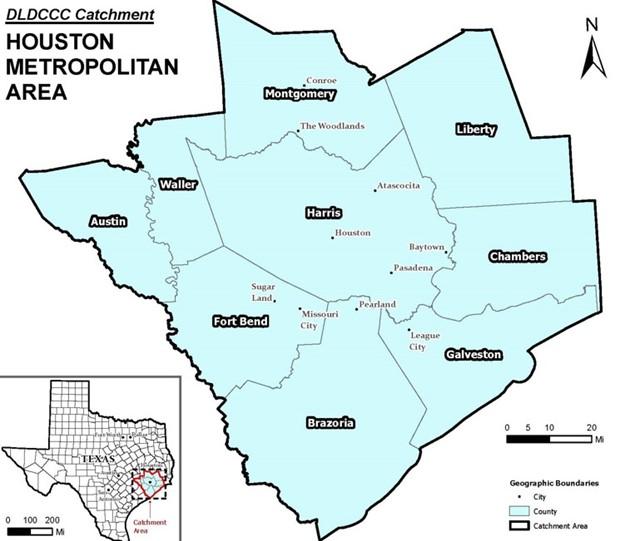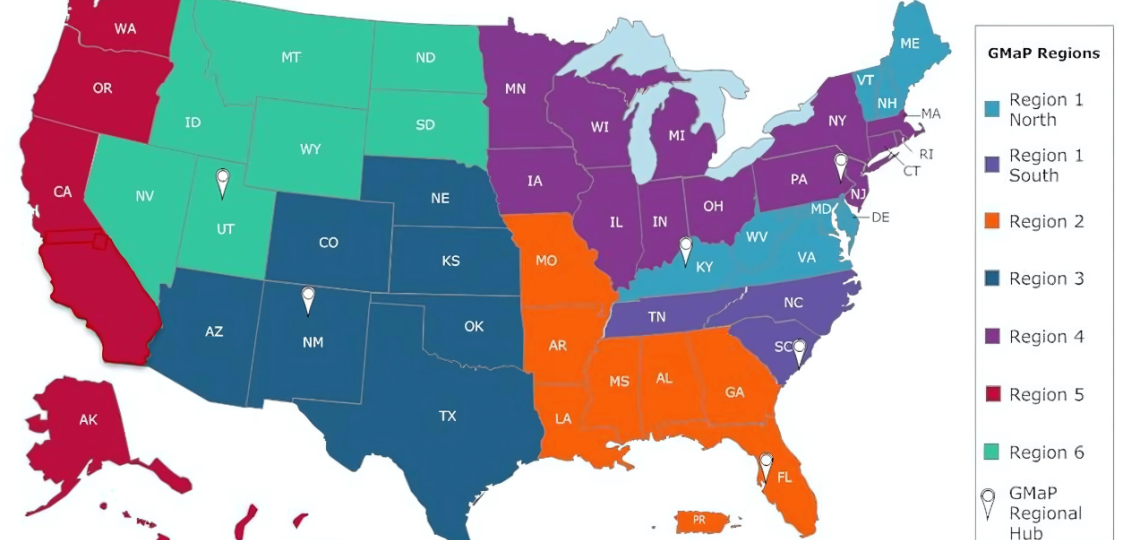Catchment Area

The Dan L Duncan Comprehensive Cancer Center serves Harris County and eight neighboring counties (Figure 1), known as our “catchment area.” Based on an evaluation conducted in 2023, 86% of our patients treated from 2019 to 2022 resided in the Houston Metropolitan area. This area includes both big cities and rural areas with fewer resources.
Home to over 7 million people, Houston is the fourth largest city in the U.S. and a cultural melting pot. Compared to the national average, people in Houston are younger, with a median age of 35 years, compared to the national median of 39 years. In addition, Houston has a higher foreign-born population (29% vs. 14%), a higher poverty rate (13.5% vs 11.1%), and a higher unemployment rate (4.2% vs 3.8%) (U.S Census Bureau and U.S. Bureau of Labor Statistics. Of note, while non-Hispanic Whites make up 34% of the population, they account for over half (53.9%) of cancer cases (U.S. Census 2018-2022, NCI SEER 22).
As is the case nationally, the four most common cancers within our CA are breast (17%), prostate (15%), lung and bronchus (12%), and colon and rectum (10%) (NCI SEER-22).
Interactive GIS Mapping Tool
To facilitate and guide cancer-related research and community outreach, the DLDCCC Leadership launched a project to create a data-rich, interactive mapping tool. There are two versions: one for DLDCCC members and one for the community. This dashboard allows users to: 1) Analyze cancer rates in different neighborhoods within the catchment area, 2) Plan and monitor recruitment for research studies and clinical trials, 3) Organize and implement community outreach and engagement efforts based on cancer screening patterns and incidence, and 4) Plan and implement tailored cancer prevention and education programs based on community need. Its user-friendly interface offers insights into cancer incidence, mortality, and risk factors, highlighting patterns, distribution, hotspots, and trends over time. The community-facing dashboard will soon be publicly available on DLDCCC platforms and social media. In partnership with the Community Outreach and Engagement Team, dashboard training will be offered for Community and Patient/Caregiver Advisory Board members, community partners/leaders, and at outreach events, in an effort to assist community engaged programs including research.
National Outreach Network
The National Outreach Network (NON) is a program from the National Cancer Institute that focuses on advancing culturally tailored cancer education and awareness among underserved communities. The goals of the NON are 1) to improve the sharing of cancer-related information between the NCI, cancer centers, and the communities we serve, and 2) to enhance involvement of all communities in cancer research, including those with less frequent representation in clinical trials. The NON assists the NCI with sharing relevant cancer information that fits the needs of all communities. Dr. Betsy Escobar, Coordinator of Community Engagement and Partnerships, serves as the DLDCCC’s NON liaison, ensuring community health workers and educators within and outside the DLDCCC and our advisory boards have relevant cancer-related information. She also interfaces with the Geographic Management of Cancer Health Disparities Program (GMaP) (NCI, 2024, designed to improve access to cancer prevention programs), which has seven hubs located at NCI-designated Cancer Centers across the U.S. (Figure 2). These hubs help researchers, students, and educators collaborate to support research and train new scientists while improving access to information and research programs for communities with less access to healthcare. Additionally, these regional networks enhance our community outreach and engagement efforts through collaborative research, training, and information sharing.

References
National Cancer Institute, SEER 22. SEER*Stat software Version 8.4.3
U.S. Census Bureau (2023). Quick Facts. https://www.census.gov/quickfacts/fact/table/US/PST040223#PST040223
U.S. Census Bureau. (2021). 2020 Census Apportionment Results Delivered to the President. Retrieved from https://www.census.gov/newsroom/press-releases/2021/2020-census-apportionment-results.html
U.S. Census Bureau 2018-2022.
U.S. Census Bureau. (2021). QuickFacts: United States. Retrieved from https://www.census.gov/quickfacts/fact/table/US/PST045219
U.S. Census Bureau. (2023). Income and Poverty in the United States: 2022. Retrieved from https://www.census.gov/library/publications/2023/demo/p60-276.html
U.S. Bureau of Labor Statistics. (2025). The Employment Situation — February 2025. Retrieved from https://www.bls.gov/news.release/empsit.nr0.htm
National Cancer Institute. (2024). Geographical Management of Cancer Health Disparities Program (GMaP). Retrieved January 2, 2025, from https://www.cancer.gov/about-nci/organization/crchd/community-outreach/gmap








